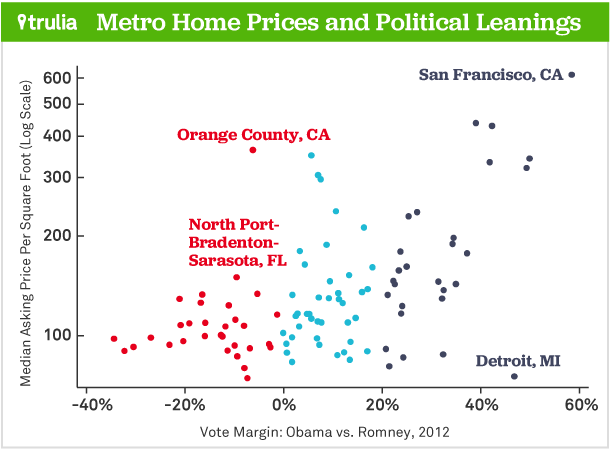The real estate site Trulia compiled some fascinating data on housing prices in both red and blue metropolitan markets. The site categorized the 100 largest metro areas as “red” or “blue” depending on how residents in those cities voted in 2012. In 32 of the 100 metropolitan areas, Republican Mitt Romney got more votes than Democrat Barack Obama. The researchers found the housing crisis and recovery affected the red and blue markets similarly but that the current lack of affordable housing is more severe in blue markets. Here’s the chart:
Trulia is reluctant to draw conclusions:
What does all this mean? The point is not that Democrats cause expensive housing, lower homeownership, or greater inequality. Determining whether and how the political views of voters or their elected officials affect local housing markets is the stuff of scholarly research, not short blogposts. But because blue markets are less affordable, have lower homeownership, and have greater income inequality, political leaders in Democratic-leaning and Republican-leaning metros may push for different policies.
My guess is that there are two possible explanations. One is that the most economically successful urban areas tend to be dominated by Democratic voters, such as major cities like New York, Chicago, Los Angeles and San Francisco. After all, Romney only captured 32 of the nation’s 100 largest metro areas. As a result, the swift economic recovery in these urban areas would put upward pressure on housing prices and lead to at least a short-term affordability problem. So maybe it’s less about political leanings, unless political leanings drive economic success (ironic, given how Republicans claim to be the pro-business party).
But the second possible explanation is that rich people — or more specifically rich liberals — may be less tolerant of new home construction in their neighborhoods. Perhaps they are more comfortable using the heavy hand of “big” local government to squelch new projects. Or perhaps they don’t see or want the economic value associated with new construction. Or maybe they favor “environmental” values and believe stopping new development is somehow the more environmental outcome (in fact, it’s the opposite, given that restricting development in the core drives new development to the fringe).
Either way, it’s a fascinating dynamic that is worth more exploration.
One thought on “Do Blue States Discriminate Against New Housing More Than Red States?”
-
Pingback: Enjoy The NFL Games Today — If You’re A Republican | Ethan Elkind
Leave a Reply
You must be logged in to post a comment.



